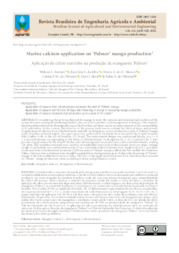Marine calcium application on Palmer mango production.
Marine calcium application on Palmer mango production.
Author(s): SIMOES, W. L.; SILVA, J. S. da; MOUCO, M. A. do C.; OLIVEIRA, C. P. M. de; SILVA, D. J.; OLIVEIRA, F. F. de
Summary: Considering the growing demand for mango to meet the national and international market and the competitiveness among the producing markets, the use of new products and management techniques that improve the potential production in the irrigated areas of the Brazilian northeast can be an important tool for the sustainability of its cultivation. In this context, the objective of the present study was to evaluate the effect of doses and periods of application of calcium from Lithothamnium seaweed via fertigation, in two production cycles of ?Palmer? mango in the Brazilian semiarid region. The experiment was conducted at the Saúde farm, located in the Projeto Senador Nilo Coelho N-09, in the city of Petrolina, PE, Brazil. The experimental design was randomized blocks, in a 5 × 4 × 2 factorial scheme, corresponding to five doses of Lithothamnium via fertigation (0, 5, 10, 15 and 20 L ha-1), four periods of application (30, 60, 90 and 120 days after flowering) and two production cycles, with three blocks, totaling 120 plots. The variables evaluated were: number of marketable fruits and parthenocarpic fruits per plant, average weight of marketable fruits and parthenocarpic fruits, and marketable fruit production. Application of 12 L per plant of calcium from Lithothamnium promotes a 20% increase in ?Palmer? mango yield in the Sub-middle São Francisco Valley. Calcium from Lithothamnium should be applied from the beginning up to 30 days after flowering of ?Palmer? mango in the Sub-middle São Francisco Valley. The effect of the application of calcium from Lithothamnium seaweed on ?Palmer? mango production varies according to doses and production cycles.
Publication year: 2022
Types of publication: Journal article
Unit: Embrapa Semi-arid Region
Observation
Some of Embrapa's publications are published as ePub files. To read them, use or download one of the following free software options to your computer or mobile device. Android: Google Play Books; IOS: iBooks; Windows and Linux: Calibre.
Access other publications
Access the Agricultural Research Database (BDPA) to consult Embrapa's full library collection and records.
Visit Embrapa Bookstore to purchase books and other publications sold by Embrapa.

